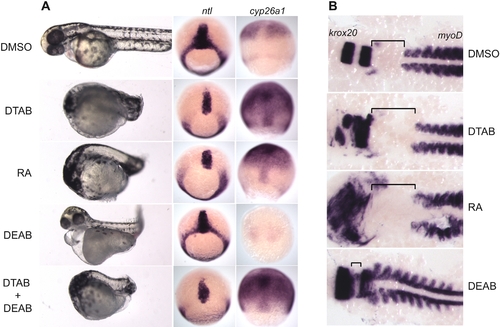
DTAB mimics effects of RA on early development.
a) Treatment with DTAB, RA and DTAB+DEAB results in anterior-posterior shortened phenotype. DEAB alone caused pericardial edema, twisted body axis and downregulation of cyp26a1. DEAB treatment did not affect the ntl staining while RA and DTAB treatment led to a loss of ntl staining in the dorsal margin. DTAB, RA and DTAB+DEAB caused an increase in cyp26a1 staining but DEAB alone caused downregulation of cyp26a1. Embryos were treated with DTAB (12.5 μM), RA (1 μM), DEAB (10 μM) and DTAB+DEAB or DMSO from 1hpf to 48hpf (for the bright field photography) and to 70% epiboly (for in situ hybridization for ntl and cyp26a1). Live bright field embryos are shown anterior to the left and dorsal to the top. In situ hybridized embryos, are shown, dorsal view with the animal pole to the top. b) DTAB and RA treatment caused an expansion in the distance between the krox20 and myoD positive domains. DEAB caused a compression of the ‘neck’ region and led to a decrease in the distance between krox20 and myoD domains. Embryos treated with DMSO, DTAB (1.6 μM), RA (0.125 μM) and DEAB (10 µM) were fixed at 9-somite stage and hybridized for krox20 (rhombomeres 3 & 5) and myoD (somites). Following in situ hybridization the embryos were de-yolked and flattened under a coverslip for better visualization.
|

